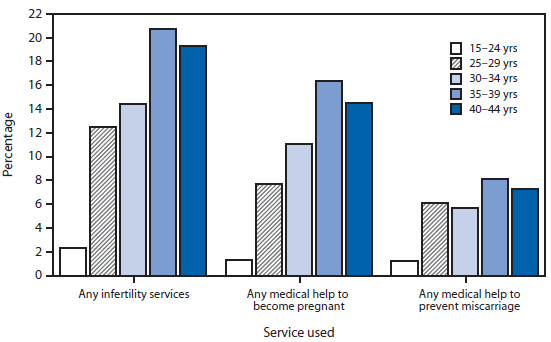QuickStats: Percentage of Females Aged 15–44 Years Ever Using Infertility Services,* by Age Group — National Survey of Family Growth, United States, 2006–2010

* Infertility services include medical help to become pregnant or to prevent miscarriage; both types of medical help could be reported.
During 2006–2010, among females aged 15–44 years, the percentage of those who ever used infertility services increased through age 34 years, leveling off for women aged 35–44 years. Approximately one fifth of women aged 35–39 years and 40-44 years had ever used infertility services, either to become pregnant or to prevent a miscarriage, compared with 2.3% among females aged 15–24 years. Use of medical help to become pregnant ranged from 1.2% for females aged 15–24 years to 16.4% for women aged 35–39 years. Use of medical help to prevent miscarriage showed a similar but less steep increase with age.
Source: Chandra A, Copen CE, Stephen EH. Infertility service use in the United States: data from the National Survey of Family Growth, 1982–2010. Natl Health Stat Rep 2014(73).
Reported by: Anjani Chandra, PhD, 301-458-4138, achandra@cdc.gov; Casey Copen, PhD.
Alternate Text: The figure above shows the percentage of females aged 15–44 years using infertility services, by age group in the United States during 2006–2010. During 2006–2010, among females aged 15–44 years, the percentage of those who ever used infertility services increased through age 34 years, leveling off for women aged 35–44 years. Approximately one fifth of women aged 35–39 years and 40–44 years had ever used infertility services, either to become pregnant or to prevent a miscarriage, compared with 2.3% among females aged 15–24 years. Use of medical help to become pregnant ranged from 1.2% for females aged 15–24 years to 16.4% for women aged 35–39 years. Use of medical help to prevent miscarriage showed a similar but less steep increase with age.
Use of trade names and commercial sources is for identification only and does not imply endorsement by the U.S. Department of
Health and Human Services.
References to non-CDC sites on the Internet are
provided as a service to MMWR readers and do not constitute or imply
endorsement of these organizations or their programs by CDC or the U.S.
Department of Health and Human Services. CDC is not responsible for the content
of pages found at these sites. URL addresses listed in MMWR were current as of
the date of publication.
All MMWR HTML versions of articles are electronic conversions from typeset documents.
This conversion might result in character translation or format errors in the HTML version.
Users are referred to the electronic PDF version (http://www.cdc.gov/mmwr)
and/or the original MMWR paper copy for printable versions of official text, figures, and tables.
An original paper copy of this issue can be obtained from the Superintendent of Documents, U.S.
Government Printing Office (GPO), Washington, DC 20402-9371;
telephone: (202) 512-1800. Contact GPO for current prices.
**Questions or messages regarding errors in formatting should be addressed to
mmwrq@cdc.gov.
 ShareCompartir
ShareCompartir


